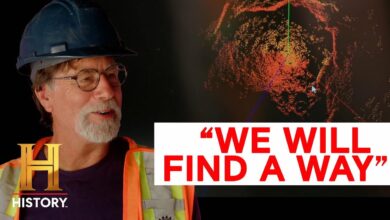Astonishing Roman Artifacts Unearthed | The Curse of Oak Island
Astonishing Roman Artifacts Unearthed | The Curse of Oak Island

NARRATOR: As a new week begins in the search to find treasure on Oak Island, Rick and Marty Lagina, along with Marty’s son Alex, Craig Tester, and Dave Blankenship, have traveled 50 miles northeast of Oak Island to St. Mary’s University in Halifax.
Here we are.
After you.
You have the– you have the goodies.
You got the goods.
Here’s what you’ve been waiting for, gentlemen.
All right, let’s see it.
NARRATOR: They are eager to determine if an object resembling an ancient Roman sword, which was reportedly found in the waters just off the coast of Oak Island, is real.
- Holy crap.
- Wow.
- Whoa.
- Whoa.
What the hell is this?
It’s a sword.
A Roman sword.
That is phenomenal.
NARRATOR: Today the team has arranged to meet with Professor Myles McCallum, an expert on Roman archaeology.
Hi, Myles.
NARRATOR: They are hoping he can determine if the sword they’ve acquired could be an important piece of evidence, one which connects the Oak Island mystery to the ancient Roman Empire.
In the lab we are going to have to ask you guys to put on some safety glasses–
OK.
–and some lab coats here.
I’ll hold that for you.
Here it is.
Oh, that’s it.
Nice.
Oh, look at that.
Bronze sword.
NARRATOR: Although it may seem unlikely that a Roman sword dating from the reign of the Emperor Commodus in the second century AD could find itself in the waters off Nova Scotia, there are many Oak Island theorists who believe it is more than possible.
In recent decades several ancient coins, identified as being Carthaginian in origin, were found in the coastal regions just north of Oak Island.
The Carthaginians were a seafaring people who dominated the trade routes of the Mediterranean during the period from 600 to 200 BC.
It has long been speculated that their knowledge of navigation, along with their shipbuilding and sailing prowess, would have made it possible for them to successfully navigate the rugged waters of the North Atlantic.
If it plays out that it is an 1800-year-old Roman sword, that’s significant.
Does it provide a certain historical context if it is real?
Yes, it does.
As far as, you know, it is obviously a representation of the demigod Hercules, who’s a really important figure among the Romans, religiously.
As far as, you know, how it’s made, that’s a bit odd.
Normally you’d expect this to be a single cast piece.
Is this one not done in one piece, then?
With respect to this, I mean, looking at it–
if we look down the side here, you can see where there’s, there’s a line that goes right up through there.
This suggests to me that it’s a bivalve mold instead of a single lost-wax mold.
So something, again, like this, this was never a functional sword.
It’s simply a work of art.
NARRATOR: In the year 70 AD, future Roman emperor Titus led the siege that conquered Jerusalem.
In the process, his armies burned and destroyed the so-called Second Temple, where the original Temple of King Solomon once stood.
When, 12 years later, the Arch of Titus was erected in Rome to celebrate the victory, it depicted a large golden menorah, one of the sacred objects taken from the Temple, which, like the Ark of the Covenant and the Holy Grail, many researchers believe were later buried on Oak Island.
Is it possible that the Romans, like the Carthaginians before them, could have traveled to Nova Scotia nearly 2000 years ago?
And if so, would a Roman sword found in the waters off Oak Island provide the proof?
Give us a percent, percent chance that this is–
Percent chance that this is something Roman?
I’m not, I’m not really in a position to tell you at this point.
You know, just looking at it as we have it here, I’m highly skeptical, just based on the construction technique, that it’s actually ancient, too.
Who would fake that?
I don’t know.
You know, it could even be a fake that’s not, you know, a modern fake, right?
It could be a fake from the 19th or 18th century.
From an Oak Island standpoint, it would actually– probably be more significant if it was a 1700s copy of a Roman–
It could be something.
It could actually be an antiquity that was in the possession of somebody who came over long after that, right?
Right.
Of course.
And lost it.
And so that’s probably– if this is something that’s old, that’s a much more likely explanation.
Why does somebody go to the effort to duplicate or fake something that almost no one in the world has seen?
I mean, I haven’t ruled it out yet.
It still could have significance to what we’re doing here.
It’s an intriguing object.
Sounds great.
Thank you very much.
No problem.
- Very informative.
- Thanks for coming.
Nice meeting you.
Yeah, same.
ALEX LAGINA: Perfect.
Thanks, Jack.
Blair, Kellen, Emma.
How are you, Sandy?
So we’ll set up here.
NARRATOR: Alex Lagina, Jack Begley, and archaeometallurgist Emma Culligan welcome numismatist Sandy Campbell to the Oak Island Interpretive Center.
Sandy has come to examine the cut copper coin that was found one week ago by Rick Lagina and Garry Drayton on lot five, a coin which x-ray fluorescence scanning has indicated may predate the 16th century.
ALEX LAGINA: OK.
So the thing that we’d like to show you is a find on lot five, which we’ve recently gained access to.
- OK.
Yeah.
So this is kind of a new area on the island for us.
OK.
We only recently got access to the lot, so we haven’t been over it with a metal detector, ourselves.
And that’s what Rick and Gary were doing when they found this.
It’s very interesting.
We’re not totally sure what it is, but we have some ideas.
OK.
Well, let’s have a look.
JACK BEGLEY: I’ll go grab the coin.
SANDY CAMPBELL: Great.
Perfect.
Here you go.
Thank you, Emma.
Here, I’ll hand it to you in the bag.
All right.
Let’s have a look.
Part of a coin, hopefully.
Time to look.
So you’ve done an XRF and a CT?
Yeah, we have.
Emma, are you able to pull that up for us, by any chance?
Sure can.
Thank you.
EMMA CULLIGAN: It’s just loading, right now.
While that loads, here’s a picture.
Let’s flip it to the other.
JACK BEGLEY: It looks like there’s some sort of characters or something inscribed on it.
SANDY CAMPBELL: Yeah, what about XRF?
Yes.
So I do have an XRF results.
And it shows high content in copper, lead, and tin, but also about 0.51% arsenic.
Yeah.
And it also has 1.05% silver in it, as well.
Which, yeah.
I mean, you can get silver naturally occurring with copper, obviously.
You know, if it has arsenic, this is pre-1500, for sure.
You know, if we weigh this, let’s weigh it.
OK.
This coin looks like there’s probably a third of it left.
JACK BEGLEY: Mm-hmm.
This is probably somewhere in the gram range, but let’s–
so it weighs exactly a gram, which, you know, is sort of unusual that it would be bang on a gram.
But you know, it’s–
Wow.
SANDY CAMPBELL: –it’s not unusual to see coins cut up and used as money in a partial payment.
Again, you know, you get a coin that’s this big, and the deal of the day required a third of that copper.
So you’re just snipping off a third of the coin, right?
Right.
And that’s really how barter worked then.
Right.
Let’s see, here.
I think this is probably– I– I’m guessing it’s either Roman.
It could even be Byzantine, but I’m thinking it’s– it’s Roman.
Roman?
No way.
SANDY CAMPBELL: Based on what I’m seeing on the coin, I mean, I–
I see Roman-style characters.
The style is definitely from 300 BC to 500-600 AD.
No way.
SANDY CAMPBELL: Yeah.
NARRATOR: A Roman coin possibly dating back over 2000 years?
But if so, who could have brought it to Oak Island?
All right.
So I’m going to have to call Rick.
I want to see–
I want to see Rick’s reaction.
Yeah, this is unbelievable.
[phone ringing]
RICK: Hello?
Hey, Rick.
RICK: Hey, Alex. How are you?
- Good.
Hey.
You– you and Gary might want to come down to the lab.
We got some pretty interesting information here for you.
RICK: We’ll be down ASAP.
OK.
See you soon.
RICK: All right.
See you.
Yeah, bye.
This is just an incredible moment because, you know, we got– we have a Roman coin on Oak Island.
And here we sit, trying to draw conclusions.
And it’s like wide open at this point.
You know, who brought it here?
How did it get here?
Why is it on lot five, in particular?
It’s just a total








